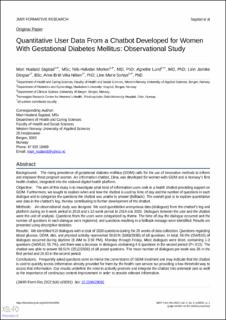| dc.description.abstract | Background: The rising prevalence of gestational diabetes mellitus (GDM) calls for the use of innovative methods to inform and empower these pregnant women. An information chatbot, Dina, was developed for women with GDM and is Norway’s first health chatbot, integrated into the national digital health platform.
Objective: The aim of this study is to investigate what kind of information users seek in a health chatbot providing support on GDM. Furthermore, we sought to explore when and how the chatbot is used by time of day and the number of questions in each dialogue and to categorize the questions the chatbot was unable to answer (fallback). The overall goal is to explore quantitative user data in the chatbot’s log, thereby contributing to further development of the chatbot.
Methods: An observational study was designed. We used quantitative anonymous data (dialogues) from the chatbot’s log and platform during an 8-week period in 2018 and a 12-week period in 2019 and 2020. Dialogues between the user and the chatbot were the unit of analysis. Questions from the users were categorized by theme. The time of day the dialogue occurred and the number of questions in each dialogue were registered, and questions resulting in a fallback message were identified. Results are presented using descriptive statistics.
Results: We identified 610 dialogues with a total of 2838 questions during the 20 weeks of data collection. Questions regarding blood glucose, GDM, diet, and physical activity represented 58.81% (1669/2838) of all questions. In total, 58.0% (354/610) of dialogues occurred during daytime (8 AM to 3:59 PM), Monday through Friday. Most dialogues were short, containing 1-3 questions (340/610, 55.7%), and there was a decrease in dialogues containing 4-6 questions in the second period (P=.013). The chatbot was able to answer 88.51% (2512/2838) of all posed questions. The mean number of dialogues per week was 36 in the first period and 26.83 in the second period.
Conclusions: Frequently asked questions seem to mirror the cornerstones of GDM treatment and may indicate that the chatbot is used to quickly access information already provided for them by the health care service but providing a low-threshold way to access that information. Our results underline the need to actively promote and integrate the chatbot into antenatal care as well as the importance of continuous content improvement in order to provide relevant information. | en_US |

